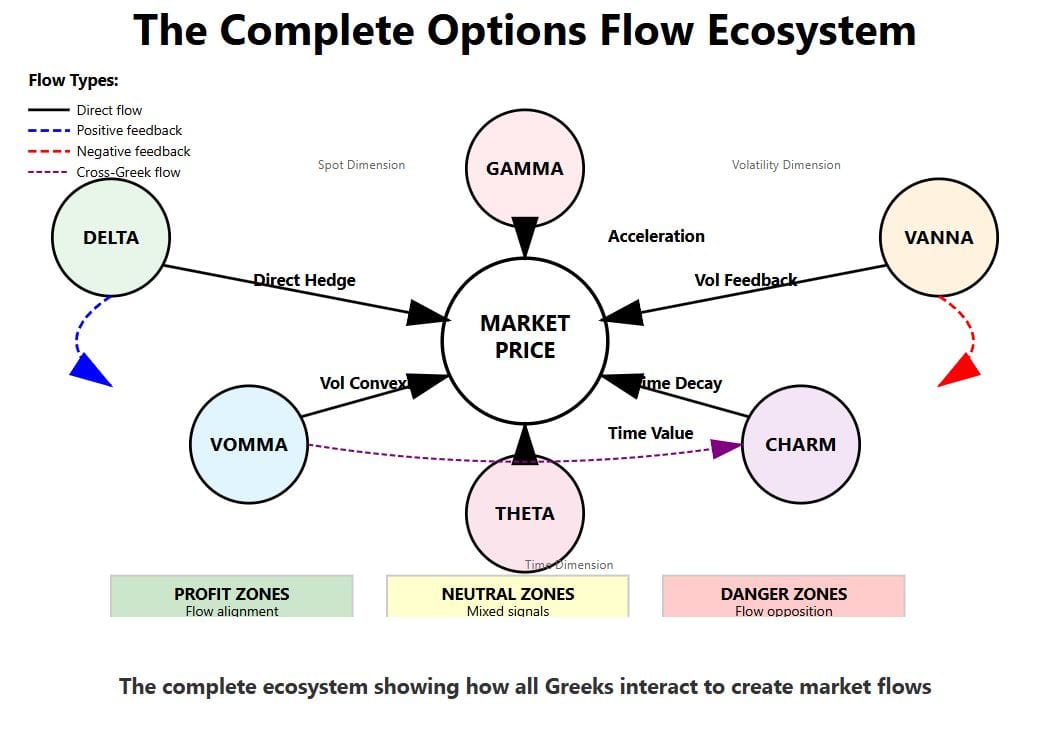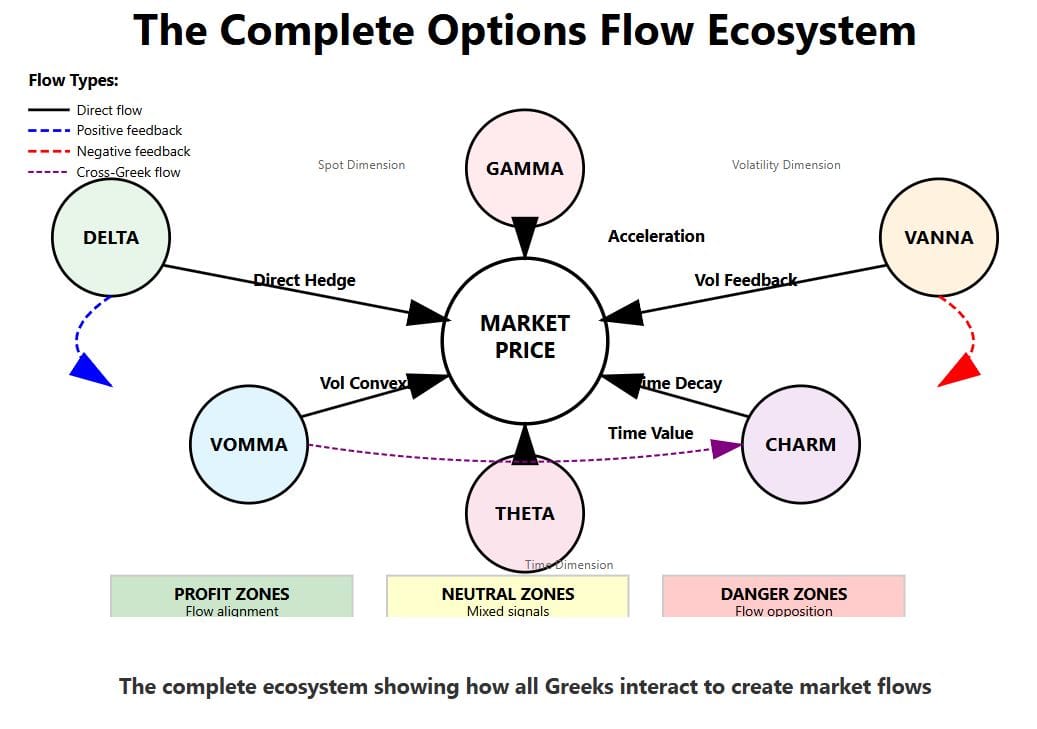Structural Options Analysis: Where Physics Meets Market Mechanics

The Framework
We've developed an options methodology that treats market positioning like a physical system. Just as objects in space exert gravitational forces on each other, options positions create measurable forces that move markets. By mapping these forces across multiple timeframes, we've built a framework that captures both the slow structural shifts and the rapid tactical opportunities they create.
The Physics of Options Flow
Every option position generates forces through the Greeks. Delta creates directional hedging flows. Gamma accelerates moves as dealers rebalance. Vanna links volatility to spot movement. Charm forces time-based repositioning. These aren't abstract concepts—they're mechanical flows that must occur.
When charm hits -4M, that's not just a number. It's dealers being forced to buy billions in notional to maintain hedges. When gamma flips negative, every downtick triggers more selling. These are predictable, mechanical responses—as reliable as gravity.
The ecosystem operates in three zones: profit zones where flow aligns with positioning, neutral zones where forces balance (our centroid), and danger zones where positioning opposes flow direction. Understanding which zone we're in determines everything from position sizing to strategy selection.
The Centroid—Market Gravity's Center

The centroid is where all positional forces balance—the market's center of mass. Like a weight on a spring, price oscillates around this level. The further it stretches, the stronger the pull back.
We calculate it by weighting every strike's positioning by its delta contribution. When price deviates beyond 0.5%, mean reversion probability exceeds 70%. This isn't hope—it's physics. The market must rebalance, and we position accordingly.
The Four Layers of Analysis

The Structural Layer (Weekly/Monthly) This is where we map the gravitational field. Major gamma concentrations create "walls" that attract or repel price. Dealer positioning determines whether moves accelerate (short gamma) or decelerate (long gamma). These structural realities define what's possible on shorter timeframes.
The Tactical Layer (Daily) Here we track how forces are shifting. Our GEX-to-Volume ratio reveals when big players are accumulating (ratio under 2%) versus distributing (above 5%). Vanna flows tell us how volatility changes will impact spot. Charm shows us time-based pressures building.
The Execution Layer (Real-time) The tape reveals whether our theoretical edges are playing out. Order flow, microstructure, cross-asset signals—this is where physics meets reality.
The Accumulation Layer (Continuous) We measure regime transition velocity—how fast the gravitational field is changing. When GEX improves by 75+ points daily, that's not adjustment; it's regime shift.
How Greeks Create Market Flows
Look at the ecosystem diagram. Each Greek generates specific, predictable flows:

Delta hedging creates the primary directional flows—the basic push and pull. But it's the second-order effects that create our edge.
Gamma determines whether moves accelerate or dampen. Positive gamma means dealers sell rallies and buy dips (stabilizing). Negative gamma means they chase moves (destabilizing).
Vanna creates the volatility feedback loop. When volatility drops, positive vanna forces buying. This is why quiet markets grind higher—it's structural, not sentiment.
Charm is time's pressure on positioning. As expiration approaches, charm explodes, forcing massive rebalancing. Those -4M charm readings aren't anomalies; they're powder kegs.
Vomma controls volatility convexity—how volatility of volatility impacts positioning. High vomma means vol moves become self-reinforcing.
Theta bleeds continuously, creating the background pressure that funds the entire ecosystem.
These forces don't work in isolation. They cascade. Charm forces dealer buying, which lowers volatility, triggering vanna buying, accelerating through negative gamma zones. One force triggers another—that's how 50-point moves happen in minutes.
Pattern Recognition Through Physics

Our documented patterns aren't arbitrary—they're configurations where forces align:
The "Charm Bomb Rally": Extreme negative charm creates irresistible upward force The "Gamma Wall Rejection": Price can't overcome concentrated positive gamma The "OPEX Explosion": All Greeks converge at expiration, creating violent repricing
These patterns repeat because the physics doesn't change. Dealers must hedge. Time must decay. Volatility must be priced.
Risk Through the Lens of Forces

Risk isn't about stop losses—it's about understanding when forces shift. A tactical stop protects against noise. A strategic stop acknowledges the gravitational field has changed. When the centroid shifts 20 points in a day, that's not variation; it's tectonic movement.
Position sizing follows force strength. When multiple forces align—centroid deviation extreme, accumulation signals strong, structural support solid—we size up. When forces conflict, we reduce or stand aside.
The Daily Process as Force Mapping
Each morning we map the force field:
- Where's the centroid pulling price?
- How is gamma distributed above and below?
- What's charm forcing today?
- Is vanna creating tailwinds or headwinds?
- Are institutions accumulating or distributing?
Only after understanding these structural forces do we look for tactical entries. It's like sailing—you must know wind and current before choosing your course.
Why Physics Beats Prediction
We don't predict where price will go. We calculate where forces push it. When dealers are short gamma below 6400 with -2M charm and deteriorating vanna, price doesn't "want" to go down—it's being pushed down by measurable forces.
This isn't technical analysis with its patterns and fibonacci levels. This isn't fundamental analysis with its earnings and economics. This is structural analysis—understanding the plumbing of markets, the mechanics that create price movement.
The Ecosystem in Action

Watch the diagram's flows. Every arrow represents billions in notional that must move. Direct hedging from delta. Acceleration through gamma zones. Volatility feedback via vanna. Time pressure from charm. These aren't suggestions—they're requirements.
In profit zones, flows align with positions—smooth sailing. In neutral zones near the centroid, forces balance—range-bound chop. In danger zones, flows fight positions—violent repricing.
Understanding which zone we're in, which forces are dominant, and how they're evolving—that's the entire game.
The Bottom Line
Markets aren't random. They're physical systems governed by the mechanics of options positioning. Every option sold creates obligations. Every Greek creates flows. Every expiration forces rebalancing.
By mapping these forces across timeframes—from monthly structural gravity to intraday momentum—we've built a framework that turns market chaos into comprehensible physics. We don't need to predict the news, guess at sentiment, or hope we're right. We simply position ourselves where forces are strongest and let physics work.
The market must respect these forces. Dealers must hedge. Time must decay. Volatility must converge. And when multiple forces align in the same direction, creating what we call "hierarchical alignment," that's not a setup—it's an inevitability waiting to unfold.
This is structural options analysis: where understanding the physics of positioning creates edges that prediction never could.
